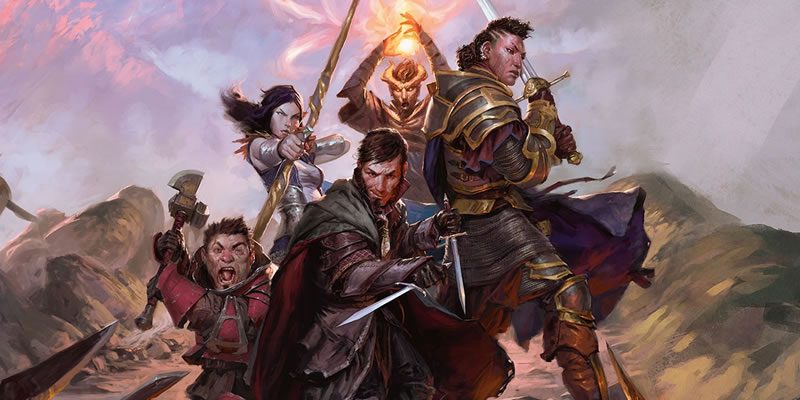Unearthed Arcana: Of Ships and the Sea Breakdown

This month’s UA article is an substantial 9-page document covering ships, sailing, crews, and ship-related downtime play. Now, obviously, you’ve already purchased Tribality Publishing’s “Naval Combat (5e): Running Sea Encounters for Ships and Monsters,” but I still encourage you to look at WotC’s version.
Core Stats
The document opens, naturally enough, by defining the stats that they’ll be using for ships. Ships are Large, Huge, or Gargantuan – though it’s not hard to imagine needing a Gargantuan+ size category, as I did in the Kaiju Codex for 5e. The surprising move is that ships don’t have square combat spaces – they might have a 20’ x 10’ space, as I don’t think we’ve otherwise seen used in 5e.
Capacity is the kind of stat we haven’t exactly needed for anything else, here measured in required crew, space for passengers (including marines), and cargo tonnage. PCs and mounts have a travel pace that sometimes comes up, but it’s central to understanding ships. Some vessels have a daily pace based on an 8-hour day, others on a 24-hour day. Finally, ships have ability scores (including 0s in Int/Wis/Cha for being, well, objects) and vulnerabilities, resistances, and immunities.
Ships have four types of Components: the Hull, the Control (such as a tiller), Movement (such as sails or oars), and Weapons. Not all ships have weapons, of course. The surprising innovation here is that components can be targeted individually – they each have their own ACs and hit point pools. Damage to the hull is, of course, the chance for total destruction. Vessels can also have multiple components of a type, such as ships with both sails and oars, offering two different movement options.
I’m surprised to see ships lose movement speed and other options as the movement options take damage and the crew gets killed off – it’s a rare case of closely tracking hit points to modify other game stats in 5e. I don’t dislike it – in fact, I think the document would be missing something without it – but it’s surprising all the same. Likewise, there are limits on directional movement and how much you can turn in a single round. These are entirely appropriate to the feel of playing a ship’s crew.
Most ships also have a damage threshold – any amount of damage less than X is ignored, but the whole value counts if it’s greater than X. Values generally range from 10-20. Since ballistae average 16 damage, you’re going to be strongly inclined to aim those at crew, sails, and the helm rather than the hull. Which… is correct use of ballistae, so that’s good. The document’s other two weapons are mangonels and rams, both considerably better for damaging a hull.
Vessels
The document includes seven vessels, from the lowly rowboat to the mighty warship – and an airship! I don’t know enough about late-medieval or early Age of Sail ships to quibble about any of the stats, but they generally look good to me. I’m not saying it should have been in a UA document, but this work is polished enough that I already want to see elven and orcish ships and ship-to-ship weaponry. I’m all about giving dwarves or gnomes siphons and Greek fire, if your setting doesn’t have a more direct Byzantine cognate. I like strikingly different ships from other species and cultures in space opera, so I expect to like ships that never appeared in the real world history in my fantasy adventures.
Crew
There are rules for six different crew jobs, from captain to ship’s surgeon, because a big part of the fantasy of having a ship is crewing the ship. They conflate navigation with the quartermaster’s job, for whatever reason – oh, probably so that you can just spike Wisdom, and expect a ranger, cleric, or druid to do well in this role. Also they don’t want you to have to have more characters than a large adventuring party.
Well, shit. I had no idea that “quartermaster” meant something completely different at sea than it does in an army. I withdraw my question. From Wikipedia:
“In land armies, a quartermaster is generally a relatively senior soldier who supervises stores and distributes supplies and provisions.
In many navies, quartermaster is a non-commissioned officer (petty officer) rank. In some navies, it is not a rank but a role related to navigation.”
The NPC crew members are collectively rated on a scale from -10 to +10, risking mutiny whenever their quality is below 0. That’s resolved with a Charisma (Persuasion) check, penalized by the current quality score (that is, you wouldn’t roll if that score weren’t negative); a bad roll makes morale continue to deteriorate.
Overall, these rules look cogent – easy to track, quick to resolve, clear narrative meaning to various outcomes. No complaints.
Travel at Sea
This is the first place where the crew roles shine, though not the last. Much like the tasks involved in overland travel in the DMG, there are tasks for maritime travel that characters undertake – some necessary, some optional. These tasks lean on the captain pretty heavily. This section doesn’t have anything for cooks or surgeons, but we’ll there.
Mapping, foraging, raising morale, navigating, noticing threats (watchstanding), repairing the ship, and sailing under concealment are the listed tasks here. The mechanics of the repair rules are noticeably generous, letting you repair damage to multiple components in a single action (though likely not a full repair). That’s a solid variety of stuff to do – then we get to hazards.
Hazards
After all, sailing is about travel over a hostile environment, and protagonist-versus-environment is the core of a hell of a lot of sailing fiction. It’s a rare sailing (or Star Trek) story that doesn’t have at least one major environmental hazard scene.
It’s a question of collective action to get the ship through the challenge. A skill challenge, one might go so far as to say. Here, they’ve decided that you roll six skill checks and a crew quality check (d20 + quality score) and add them together.
…do what now?
Don’t get me wrong, it works fine. It generates a number from 0 (total Disaster) to 140+ (Great Success). Any unfilled crew jobs are resolved as a roll of 0, so that’s a bad problem. A Disaster is, indeed, a serious loss – some crew killed, some crew quality score lost, damage to the ship, and loss of a day’s travel. You’re not super likely to get this result, but it certainly could happen. It feels like it’s a situation with brutal stakes, where PCs probably can’t bluster their way past the problems – though a number of hazards could probably be resolved by a druid with the right spell prepared. I very faintly wish they had gone a little deeper on fantasy here, and listed “ship’s mage” as a normal officer post.
For at least a fair variety of skill challenge situations, including many forms of vehicular travel and maintenance of a structure, I’d embrace this summed-result and chart-lookup model. The trick is getting the right number of required posts. For a lot of parties, this model is going to require several NPCs in crew posts. That’s an interesting model too – it pushes you to prioritize interactions with those NPCs and take a greater interest in their agendas.
There’s a further list of incidents that require a single skill check. Because they turn on a single die roll, even a skilled character could easily blow a DC 15 check. Each day of travel has a 10% chance of an event, and these events could ruin your crew quality score in a hurry. Knowing the rules communicates the kind of tension that a long sea voyage in an early technological axiom should generate. My favorite part: the Medicine skill does something.
Ships in Combat
This section explains a bit more about how ships act in combat, though I’m still a little shaky on the line between individual actions and acting as part of the crew. I think it’s saying that the ship’s actions (movement and weapons) behave more-or-less like lair actions, as directed by the captain.
There are also new actions for the captain, first mate, and bosun. Full Speed Ahead is a speed boost, of course, while Fire at Will is a Help action for the ship’s weapons. I like these two, though I’d also like a few more options, on general principles.
The Crashing rules emphasize just how bad things get in collisions at sea, though even 16d10 isn’t a problem, as such, for a warship’s 500-hit-point hull. I have some concern that ramming krakens may become too optimal of a strategy.
As a quick (if extreme) example, let’s check out the leviathan from XGTE (p. 198). Siege Monster is doubling its damage, so it’s averaging 124 damage per round (40 for each of two slams, 44 for its tail). Assuming they’re able to damage it at all, I’m pretty sure any PCs that have any business fighting a leviathan – we’ll call it 11th level and above – aren’t going to have too much trouble kicking out 328 damage before that 124 is a real problem, to say nothing of any extra damage the crew deals with ship weapons. Good use of Tidal Wave might change the game, but it’s harder to be sure without mapping the whole thing out. The leviathan does considerably worse if it attacks the PCs or crew directly, since that costs it the Siege Monster trait.
Owning a Ship
Finally, the downtime responsibilities of owning a ship. Profit is more likely than with other downtime business ventures. After the initial investment for buying the ship and hiring the crew, they turn a steady profit, unless there’s a Complication. As written, you can expect to see a Complication about once every four months. Four of the six Complications require some degree of personal intervention, so this is generating content that concerns you directly about twice per campaign year. As with all of the Complication tables for downtime activity, the DM should plan to cross off Complications that occur and replace them with new material, because most of these are interesting once and deeply aggravating twice.
Conclusion
This is an incredibly strong, polished document. I can find very little to quibble with here – at worst, a few places where I would like more variety, and in general the leviathan doesn’t feel scary enough (or it isn’t obvious enough how you would use it well). I have some vague, haven’t-crunched-the-numbers concerns about the interaction of spells of 3rd level and upward and the assigned values for ships. It is better than a caster declaring that they’re targeting their disintegrate at the ship’s hull right at the waterline, and expecting that to be the end of it for that ship. This document shows that that’s just as incorrect as demanding that the spell one-shot a powerful enemy by targeting its head.
Without doing a point-by-point rundown, I would say that Tribality Publishing’s Naval Combat offers a fairly similar game experience, but with chase rules, more cannons, and Age of Sail technology, while UA offers lower tech and a different focus to its peripheral material (such as the downtime activity content). Taking the strongest points from the two documents to create a single game experience should be straightforward and rewarding.



